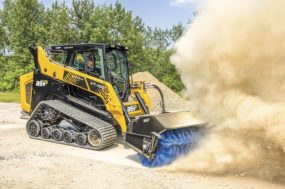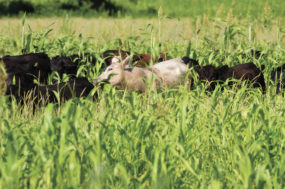Farming is a lot like football. The players must be aggressive to score, but we play smart defense. Always setting goals and creating a game plan to meet those goals is a common denominator. After all, the Cowboys start the year planning to be world champions. Eventually, as the season drags on, just making the playoffs becomes a major goal. Much like football, growers’ plans are based on an anticipated goal but may need to pivot when those goals aren’t met.
Erosion reduction
Erosion reduction is the number one priority of any nutrient management plan (NMP) and should be the number one goal of every grower. It’s the grower’s decision to decide on a “prevent defense” or to put in the “goal line defense.” We can do the minimum possible – keeping soil loss below tolerable soil loss (T), but this prevent defense may not be enough. To ensure high-producing soil for years to come, it requires a goal line defense.
There are many tools at a grower’s disposal to help play better defense against soil loss. The soil’s best defense is some sort of protection. This could come from crop residue remaining after harvest or planting a cover crop. The longer the soil is kept covered, the better it will do in the battle against erosion. This will likely look like a mix of soil coverage and having a diverse mix of plants in rotation.
Additional feed sources
Feed requirements can also dictate the forage game plan. Could a high-yield, lower-quality feed fit into the game plan? Could a nurse crop silage accompany alfalfa seeding? A high-yielding play could include a rye forage followed by corn silage. While corn silage planted after rye may end in a slight yield reduction, when the ryelage crop harvested in midspring is added into the strategy, even more tons will likely be produced per acre than from corn silage alone.
Alfalfa establishment can be a double-edged sword when it comes to erosion. As one of the only perennial crops grown on-farm, it has tremendous erosion-preventing benefits. The challenges arise with alfalfa establishment. The soil is generally heavily tilled to help create a smooth surface and to promote good seed-soil contact. This heavy tillage, generally accompanied by some sort of roller, can lead to a smooth, low-structured soil very susceptible to erosion. In the past, a companion crop was planted with alfalfa at the time of seeding. Many producers have gotten away from a companion crop and shifted to direct seeding. Some of the advantages to adding a companion crop at establishment include increased first-year yield, major erosion benefits and increased weed suppression.
Diversified rotations
A healthy soil will have better structure and therefore resist soil erosion. One of the best ways to increase soil health is by implementing a diverse crop rotation. Even in a continuous corn silage program, fall-seeded cover crops allow the soil to recover from the stress of corn silage harvest.
The cover crop helps break up soil compaction and simulates soil biological life by having a growing plant present most of the year.
If it’s time to take the cover crop game one step further, growers should consider interseeding the cover crop early in the growing season. A small-grain cover crop lends itself well to this practice. Many growers are turning to a more diverse cover crop mix when interseeding early in the year. If equipment is unavailable for this, or the early seeding feels too risky, growers should consider aerial application of the cover crop prior to harvest. The stand success can be quite variable with broadcast application of cover crop. If harvesting the cover crop for forage is the intention, it would be less risky to drill the cover crop after harvest.
While growers may not need to consider “competition” in the traditional game sense, the environmental challenges working against them each year could very well be considered competition for forages. To throw off the competition, turning a traditional gameplan on its head could be considered a good strategy. In such cases, consider adding additional forage crops to the rotation. Alfalfa haylage may be No. 1 on the depth chart, but a lot of other players can be used.
One key group of players is forage sorghum, sorghum-sudan and sudangrass. These will all provide a high-quality, high-yield forage outside of haylage. They can be planted on some tougher soils that don’t usually grow quality alfalfa or corn silage. These can also be planted following wheat or another short-season crop. Small-seeded grasses such as oats, wheat, rye and triticale are also great forage additions following wheat – but could also be running backs following a corn silage blocker. To further switch things up and keep the game strategy fresh, look toward a forage soybean crop or even millet.
When hitting the field next year, don’t be afraid to try new plays. There is no need to run the same offense and defensive strategy throughout the game when trying something new could help put more points on the scoreboard. Try a field or two of rye planted after corn silage. Maybe throw some sudangrass in after your winter wheat. The new playbook might not be comfortable, but it could be the next Jet sweep.










